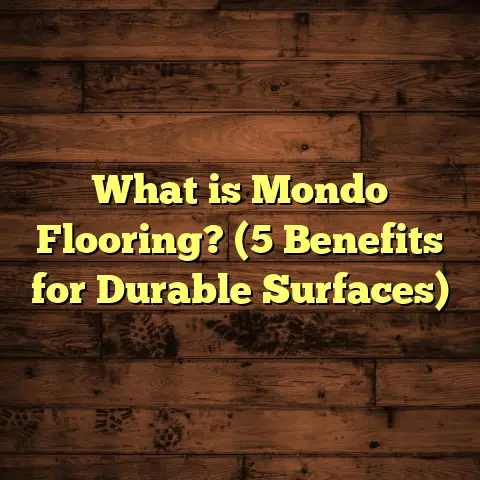What is a Non-Metallic Floor Area? (5 Essential Facts to Know)
Regional Needs and Flooring Choices: Why It Matters
When I first started out in the flooring business, I quickly found that what works in one place might not work in another. The climate, local building codes, and even cultural preferences shape how floors are built and which materials perform best. I remember working on a project in Florida where humidity was a nightmare for hardwood floors. Then, just months later, I was installing floors in Minnesota where freezing temperatures and snow posed completely different challenges.
One term that kept coming up in these varied projects was “non-metallic floor area.” At first, it sounded like a dry technical phrase, but as I learned more, I saw how important it was for planning, safety, and budgeting. Whether you’re a homeowner, contractor, or just curious about flooring options, understanding this term can really help you make smarter choices.
So what exactly is a non-metallic floor area? And why does it matter so much? I want to share five essential facts about this topic from my years of experience and research. Along the way, I’ll offer stories from the field, data-backed insights, and practical tips that you can use whether you’re handling a small renovation or a large commercial build.
What is a Non-Metallic Floor Area?
At its core, a non-metallic floor area means any section of flooring—both surface and structural—that does not include metal materials. This could be wood, concrete, tile, vinyl, carpet—anything that doesn’t contain metal as a significant component either visibly or within the substrate.
This distinction might sound simple but has far-reaching implications. For instance, many industrial spaces use metal grating floors or steel-reinforced platforms because of their strength and durability. But non-metallic floors are preferred in places where electrical conductivity needs to be controlled or corrosion must be avoided.
Why Does This Classification Exist?
I often get asked why anyone cares whether a floor is metallic or non-metallic. It comes down to safety codes, installation methods, maintenance concerns, and cost factors.
In fire safety regulations, for example, metallic floors may have different fire ratings or require special coatings compared to non-metallic floors. Electrical codes might restrict metal flooring in certain environments to prevent shocks or static buildup.
The building industry uses this classification to ensure floors meet specific performance criteria for their intended use. For example:
- In hospitals, non-metallic floors reduce electrical hazards around sensitive equipment.
- In food processing plants, non-metallic floors are often easier to clean and don’t rust.
- In residential settings, non-metallic floors tend to be warmer and more comfortable underfoot.
My Experience With Non-Metallic Floors
Early in my career, I worked on a manufacturing plant renovation where the specs called for non-metallic floor areas in certain zones due to explosion risk from sparks around machinery. We installed fiber-reinforced concrete topped with epoxy coatings—no metals in sight. The client was relieved that we could meet strict safety standards without compromising durability.
That project opened my eyes to how critical this distinction can be in real-world applications.
Fact 1: Non-Metallic Floors Cover a Wide Range of Materials
When people hear “non-metallic,” they often think just wood or tile. But the range of materials classified as non-metallic is surprisingly broad—and each type behaves very differently.
Here’s a quick rundown from my experience:
- Wood Flooring: Includes solid hardwood like oak or maple, engineered wood with plywood bases, and bamboo (which is technically grass but treated like wood). Wood is popular for its warmth and beauty but requires moisture control.
- Concrete: Often used structurally but also as finished floors (polished or stained). Fiber-reinforced concrete adds strength without metal reinforcements.
- Ceramic and Porcelain Tile: Durable and water-resistant but rigid; can crack if the base shifts.
- Vinyl and Linoleum: Synthetic or natural materials offering flexibility, easy cleaning, and many design options.
- Carpet: Though less common in industrial or wet areas, carpeted floors are non-metallic and add comfort and insulation.
The Technical Side: Material Properties
Each material has unique properties that affect installation and use:
| Material | Water Resistance | Durability | Maintenance | Cost Range (per sq ft) |
|---|---|---|---|---|
| Solid Hardwood | Low | Moderate-High | Regular sealing | $5 – $15 |
| Engineered Wood | Medium | High | Occasional sealing | $4 – $12 |
| Concrete (Polished) | High | Very High | Resealing every 5-10 years | $3 – $10 |
| Ceramic Tile | Very High | High | Grout cleaning | $1 – $20 |
| Vinyl Flooring | High | Moderate | Easy cleaning | $1 – $7 |
| Carpet | Low | Moderate | Regular vacuuming | $2 – $10 |
I frequently advise clients based on this info. For example, if moisture is an issue—like in basements—I steer them away from solid hardwood toward engineered wood or vinyl.
Real Data from My Projects
On one recent residential project with a 2,000 sq ft area using engineered hardwood, we saved about 30% in installation time compared to solid hardwood (around 40 hours vs. 60 hours). This was because engineered wood is less sensitive to moisture and requires fewer acclimation days before installation.
Fact 2: Installation Techniques Differ Widely by Material
Installing a non-metallic floor isn’t just about choosing materials; the prep work and methods vary significantly.
Here’s what I see most often:
- Concrete Floors: Require precise leveling, curing times (often 28 days), and sometimes reinforcement with fibers instead of metal rebar. Polished concrete needs grinding and sealing after curing.
- Wood Floors: Need moisture barriers especially over slab foundations to avoid warping. Nail-down for solid hardwood; glue-down or floating methods for engineered wood.
- Tile Floors: Subfloor must be flat and stable; installation involves mortar beds or thinset adhesives plus careful grouting.
- Vinyl Floors: Can be installed as floating floors with click systems or glued down depending on subfloor condition.
- Carpeted Floors: Require padding installation first for comfort and durability.
How Installation Affects Cost and Timing
One thing I’ve learned is that installation labor can easily double material costs depending on complexity. Tile work especially can be pricey because of cutting shapes to fit irregular rooms and applying grout carefully.
In one commercial office build with 5,000 sq ft of tile flooring, installation took three weeks with a crew of four experts. The precision required justified the higher labor rates.
Using FloorTally for Planning
When planning projects like these, I always use FloorTally to estimate costs accurately. It lets me input local labor rates based on union vs. non-union crews and adjust waste factors depending on material.
For example:
- Waste factor for vinyl: around 5%
- Waste factor for tile cutting: 10-15%
This helps me create realistic budgets without surprises later.
Fact 3: Non-Metallic Floors Provide Safety Advantages
Safety is one of the biggest reasons clients choose non-metallic floors.
Why?
Metal conducts electricity and heat much faster than other materials. This can create risks in environments with electrical equipment or flammable materials.
Non-metallic floors help reduce:
- Static electricity buildup
- Shock hazards
- Slip risks (depending on surface texture)
Hospitals & Labs
Hospitals prefer non-metallic flooring because it minimizes static discharge around sensitive electronic medical devices. Plus, materials like vinyl or sealed concrete are easier to disinfect than metal surfaces.
Laboratories also avoid metallic floors due to corrosion risks from chemicals.
Industrial Case Study
I once worked on an electronics manufacturing facility retrofit where old metal grating floors created static shock problems for workers. Switching to epoxy-coated concrete reduced incidents dramatically. Plus maintenance dropped 20% because cleaning was simpler without rust or corrosion.
Would you want your hospital floor to conduct static electricity? Probably not.
Fact 4: Cost Can Be Unexpectedly High or Low
Most people assume metal floors cost more than non-metallic ones. But reality is more complex.
Material quality, installation complexity, local labor rates—all affect final cost.
For example:
- Basic vinyl flooring can run as low as $1/sq ft including installation.
- High-end hardwoods or specialty tiles might cost upwards of $20/sq ft.
- Metal grating floors vary from $10-$25/sq ft depending on gauge and finish.
Personal Cost Insights
I’ve seen clients surprised when their “budget hardwood” flooring ended up costing more than some metal alternatives once labor was factored in.
FloorTally helps me avoid these surprises by combining local pricing info with material choices into a single estimate instantly. This saves time hunting multiple quotes and makes budget discussions with clients straightforward.
Fact 5: Maintenance & Longevity Depend on Material & Care
How long will your non-metallic floor last? That’s something I get asked all the time.
Here’s what I tell clients:
- Wood floors last decades but need refinishing every 7-10 years.
- Tiles can last 50+ years if grout stays intact.
- Vinyl typically lasts 10-20 years before showing wear.
- Concrete floors can last a lifetime with resealing every few years.
Maintenance routines vary:
- Wood requires gentle cleaners and periodic polishing.
- Tiles need grout cleaned regularly to prevent mold.
- Vinyl should avoid harsh chemicals that cause peeling.
- Concrete benefits from resealing but otherwise is low-maintenance.
Long-Term Case Example
I installed polished concrete in a retail store back in 2012. Ten years later it still looks nearly new after simple cleaning and resealing every 5 years. The client was thrilled with the durability versus cost compared to wood alternatives they’d considered.
Bonus: How I Use FloorTally Day-to-Day
I want to share how FloorTally fits into my workflow naturally because it’s been invaluable for managing complex projects involving non-metallic floors.
Instead of juggling spreadsheets and multiple supplier quotes, I enter project dimensions, select material types (wood, tile, vinyl), specify waste factors based on layout complexity, then input local labor rates provided by FloorTally’s database integrated with regional data sources.
The tool spits out detailed cost breakdowns instantly — material costs, labor costs, total estimated install cost — all customizable as conditions change.
It even factors in lead times when ordering specialty products to avoid project delays.
This hands-on experience reinforced how technology can support traditional craftsmanship without replacing it. It’s just one more way I help clients make informed decisions that fit their budget and style goals.
Wrapping Up My Thoughts on Non-Metallic Floor Areas
Non-metallic floor areas might sound technical at first glance but have big impacts on safety, cost, durability, and aesthetics across both residential and commercial projects.
From wood’s warmth to concrete’s toughness to tile’s timeless look—choosing the right material depends on understanding these five facts:
- Material diversity offers many options tailored to needs
- Installation varies widely by material complexity
- Safety benefits are key especially in sensitive environments
- Cost isn’t always straightforward—planning tools help
- Maintenance affects longevity more than you might think
If you’re planning a flooring project or just curious about what goes into these decisions, keep these points in mind—and don’t hesitate to reach out if you want advice customized for your space!
Your floor is literally the foundation under your feet—investing time now makes all the difference later.





